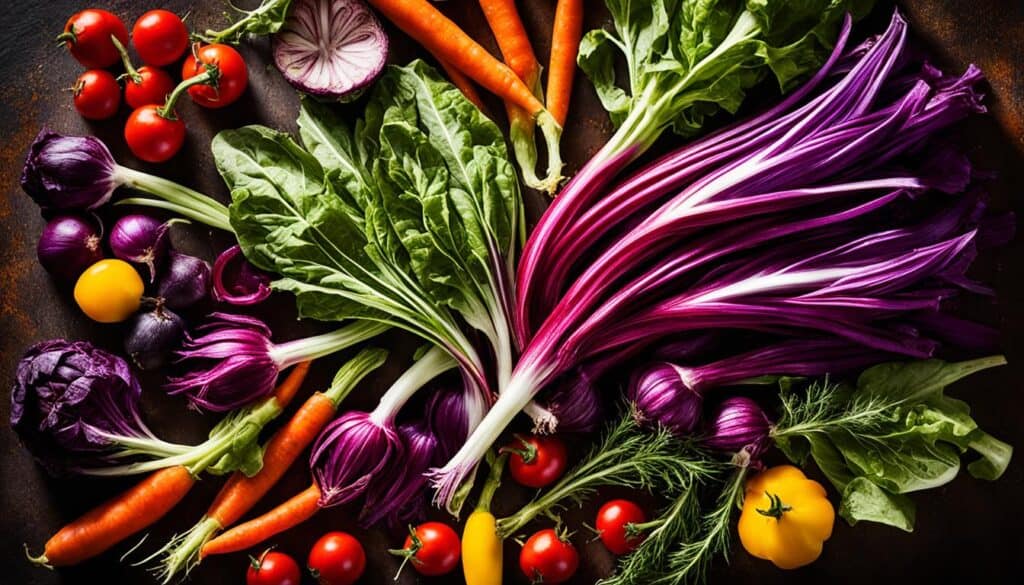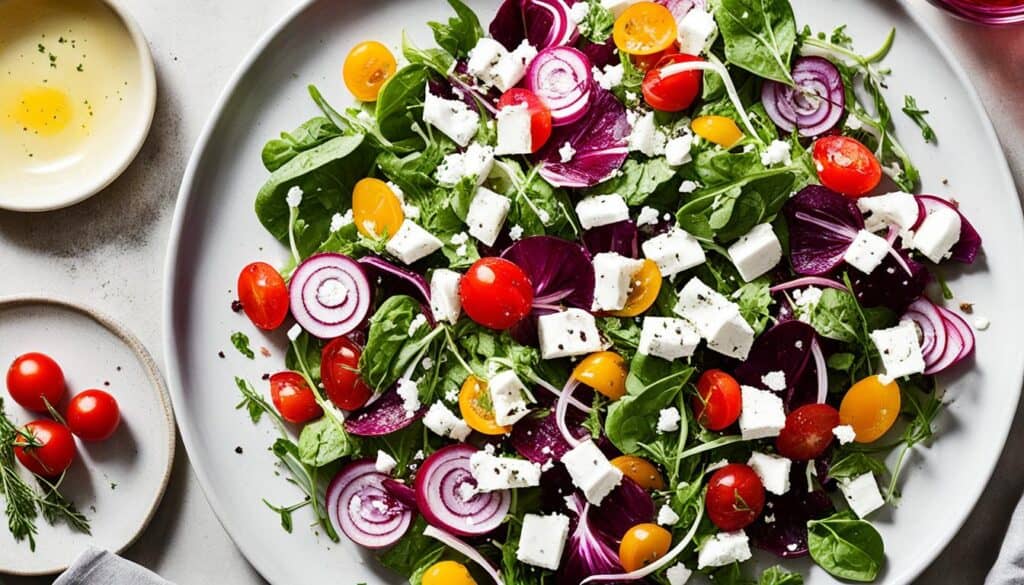Did you know that red chicory, also known as red endive or red leaf chicory, is a versatile vegetable that not only adds a burst of flavor and color to your meals but also offers numerous health benefits? This vibrant veggie is packed with essential vitamins and powerful antioxidants, making it a must-have addition to your culinary repertoire. Whether you enjoy it raw in salads or cooked in various dishes, red chicory is sure to impress with its stunning visual appeal and delightful taste.
Key Takeaways:
- Red chicory is a versatile and nutrient-rich vegetable that adds flavor and color to meals.
- It is packed with essential vitamins and powerful antioxidants, offering numerous health benefits.
- Red chicory can be eaten raw in salads or cooked in various dishes.
- It is a great addition to gourmet salads and Mediterranean cuisine.
- Red chicory is available year-round and can be easily incorporated into your diet for a vibrant and flavorful culinary experience.
The Beauty of Red Chicory
Red chicory, also known as red leaf chicory, is a visually stunning vegetable with its vibrant deep purple leaves. The leaves have a touch of bitterness, which adds complexity to the flavors.
Red chicory is often used in salads, where its striking color contrasts beautifully with other ingredients. Its crunchy texture and slightly bitter taste make it a perfect addition to gourmet salads. Whether raw or cooked, red chicory is sure to impress with its visual appeal and delicious taste.
If you’re looking to create a visually captivating salad, red chicory is a fantastic choice. Its deep purple leaves provide a stunning backdrop for other salad components, making for a visually appealing dish. Pair it with complementary ingredients like creamy goat cheese, toasted walnuts, and tangy balsamic vinaigrette for a flavor-packed experience.
“Red chicory’s vibrant color and slightly bitter taste bring a unique element to salads, making them more exciting and visually appealing.” – Chef Maria Delgado
Red chicory can also be sautéed or grilled to bring out its unique flavor profile. When cooked, the bitterness of the chicory mellows out, creating a delicate and satisfying taste. Add sautéed red chicory to pasta dishes or use it as a flavorful topping for grilled meats.
With its captivating appearance and versatile nature, red chicory is a wonderful addition to any gourmet kitchen. Explore its beauty and enjoy the delightful flavors it brings to your meals.
The Health Benefits of Red Chicory
I’m excited to share with you the incredible health benefits of red chicory. Not only does this vibrant vegetable delight your taste buds, but it also provides a range of nutrients that can support your overall well-being.
Rich in Essential Vitamins
Red chicory is packed with essential vitamins, including vitamin C and vitamin K. Vitamin C plays a crucial role in supporting a strong immune system, helping your body fight off infections and illnesses. Meanwhile, vitamin K is essential for healthy blood clotting, promoting proper wound healing and preventing excessive bleeding.
Promotes Digestive Health
One of the standout benefits of red chicory is its high fiber content. Fiber plays a key role in promoting digestive health by adding bulk to your stool and preventing constipation. Including red chicory in your diet can help keep your digestive system running smoothly and maintain regular bowel movements.
Powerful Antioxidants
Red chicory is rich in anthocyanins, a type of antioxidant that gives fruits and vegetables their vibrant colors. These antioxidants have been linked to numerous health benefits, including reducing inflammation, improving brain function, and lowering the risk of chronic diseases such as heart disease and certain cancers.
Adding red chicory to your meals is a delicious way to enhance your well-being. Whether you enjoy it raw in salads or cooked in various dishes, this nutrient-dense vegetable can contribute to a healthier lifestyle.
Explore the infographic below to discover the specific health benefits of red chicory:
| Health Benefits of Red Chicory | Description |
|---|---|
| Boosts immune system | Vitamin C in red chicory strengthens your body’s natural defenses. |
| Supports healthy blood clotting | Vitamin K in red chicory promotes proper blood clotting, aiding in wound healing. |
| Promotes digestive health | The high fiber content of red chicory helps maintain regular bowel movements. |
| Reduces inflammation | Antioxidants in red chicory, such as anthocyanins, have anti-inflammatory properties. |
| Improves brain function | The powerful antioxidants in red chicory may enhance cognitive function. |
| Reduces the risk of chronic diseases | The anthocyanins in red chicory have been associated with a lower risk of heart disease and certain cancers. |
Growing Red Chicory in Your Garden
If you’re interested in growing red chicory in your own garden, it’s relatively easy to do so. Red chicory can be started from seeds, which should be sown in mid to late June for a fall harvest. The seeds can either be directly sown into prepared garden beds or started in flats.
Chicory seeds prefer soil temperatures of around 65-75 degrees Fahrenheit for optimal germination. Once the plants are ready to harvest, you can simply peel back the outer layers to reveal the compact heads of red chicory. Red chicory thrives in full sunlight and requires regular watering, about 1-2 inches per week.
Interplanting red chicory with other crops, such as salad mix or radishes, can maximize space in the garden and provide a diverse harvest.
| Planting Season | Soil Temperature | Light Requirements | Watering Needs |
|---|---|---|---|
| Mid to late June | 65-75 degrees Fahrenheit | Full sunlight | About 1-2 inches per week |
Interplanting Tips
- Maximize space in your garden by interplanting red chicory with other compatible crops such as salad mix or radishes.
- Consider the growth habits and space requirements of each plant to ensure they can thrive together without overcrowding.
- Strategically plan the layout of your garden, placing taller plants at the back and shorter plants in the front to maximize sunlight exposure for all crops.
“Interplanting red chicory with other crops not only saves space but also creates an aesthetically pleasing and diverse harvest.” – Gardening Enthusiast
By following these simple steps, you can enjoy the satisfaction of growing your own red chicory and harvest the vibrant and flavorful vegetable right from your garden.
The Culinary Delights of Red Chicory
Red chicory’s versatility extends beyond salads. It can be used in a variety of culinary creations, adding flavor and visual appeal to your dishes. Red chicory can be sautéed with garlic and olive oil, grilled for a smoky touch, or roasted for a caramelized sweetness. Its slightly bitter taste pairs well with creamy dressings and strong cheeses. Red chicory can also be used as a base for a refreshing and colorful slaw. From appetizers to main courses, there are endless possibilities to explore with red chicory in the kitchen. Get creative and let the vibrant flavors of this vegetable shine in your next culinary adventure.
Try some of these delicious red chicory recipes:
| Recipe | Description |
|---|---|
| Red Chicory Salad | A refreshing salad made with red chicory, mixed greens, walnuts, and a tangy vinaigrette dressing. |
| Grilled Red Chicory with Balsamic Glaze | Tender red chicory lightly charred on the grill and drizzled with a sweet and tangy balsamic glaze. |
| Radicchio Risotto | A creamy and flavorful risotto made with arborio rice, onions, Parmesan cheese, and sautéed radicchio. |
| Caramelized Red Chicory Tart | A savory tart with a flaky crust, topped with caramelized red chicory, goat cheese, and fresh herbs. |
These recipes showcase the versatility of red chicory and highlight its unique flavors. Incorporate red chicory into your culinary repertoire and discover the delightful taste it brings to your dishes.
Red Chicory’s Role in Mediterranean Cuisine
Red chicory, also known as radicchio, plays a vital role in the rich and flavorful Mediterranean cuisine. This vibrant vegetable is a favorite ingredient in various Mediterranean dishes, adding a burst of color, texture, and flavor. From Italy to France and Spain, red chicory brings its unique characteristics to create exquisite flavor combinations and enhance the overall culinary experience.
In Italian cuisine, red chicory is widely used in risottos, pastas, and salads. Its distinct bitterness serves as a perfect counterbalance to the richness of other ingredients, creating a harmonious blend of flavors. Whether it’s a creamy risotto with red chicory or a refreshing salad tossed with this vibrant vegetable, red chicory adds depth and complexity to Italian dishes.
French and Spanish cuisines also embrace the versatility of red chicory. In French cuisine, it is often used in salads, tarts, and braised dishes. Its slightly bitter taste and unique texture make it a standout ingredient that complements a wide range of flavors. Spanish cuisine incorporates red chicory into dishes like tapas, stews, and grilled vegetables, providing a delightful contrast to other ingredients and contributing to the distinct Mediterranean flavor profile.
Red chicory’s vibrant color and robust flavor make it a natural fit for Mediterranean cuisine. Its versatility allows it to be used in both simple and complex dishes, providing an array of culinary possibilities. Whether it’s a light salad, a hearty stew, or a gourmet masterpiece, red chicory elevates the taste and presentation of Mediterranean dishes, making them a feast for the senses.
| Cuisine | Common Dishes |
|---|---|
| Italian | Risottos, pastas, salads |
| French | Salads, tarts, braised dishes |
| Spanish | Tapas, stews, grilled vegetables |
Red chicory’s role in Mediterranean cuisine extends beyond its culinary applications. This vibrant vegetable not only adds flavor and visual appeal to dishes but also provides essential nutrients and health benefits. Its rich vitamin and antioxidant content contribute to overall well-being, making it a valuable addition to a balanced and healthy diet.
Red Chicory and its Culinary Allies
Red chicory belongs to a diverse family of greens known as the chicory family. This family includes various greens like radicchio, dandelions, and lettuces. Within the chicory family, there are different varieties with distinct flavor profiles, colorations, and shapes. Radicchio, with its red and white striped leaves, is one of the most commonly recognized varieties. Puntarelle, with its elongated pale green spears, is another popular variety. Belgian endive, also known as witloof endive, features pale white to yellowish-green elongated chicons. Frisée and escarole are other notable members of the chicory family. Each variety offers its own unique texture and flavor, making the chicory family a versatile and exciting culinary ally.
When combined with red chicory, these other members of the chicory family create a dynamic and flavorful chicory mix. The variety of flavors, textures, and colors adds depth and complexity to dishes. Whether using a combination of red chicory and radicchio for a colorful salad or incorporating Belgian endive and frisée in a gourmet appetizer, the chicory family is a culinary team that elevates any meal.
Chicory Varieties
| Variety | Color | Shape | Flavor |
|---|---|---|---|
| Radicchio | Red and white striped leaves | Round heads | Bitter with a slight sweetness |
| Puntarelle | Elongated pale green spears | Spear-like shape | Mild and crisp |
| Belgian Endive (Witloof Endive) | Pale white to yellowish-green elongated chicons | Curved shape | Mild and nutty |
| Frisée | Frilly green leaves | Curly texture | Bitter with a pleasant bite |
| Escarole | Dark green leaves with broad stems | Loose leaf | Bitter and slightly sweet |
The chicory family provides an assortment of flavors and textures that can be used in salads, soups, stir-fries, and more. Experimenting with these different chicory varieties is a great way to explore new culinary horizons and add excitement to your dishes. Whether you’re a fan of the bitter notes of radicchio or prefer the milder taste of Belgian endive, there’s a chicory variety to suit every palate.
A Brief History of Chicory
Chicory has a long documented history dating back to ancient Rome and Greece. References to chicory can be found in ancient cookbooks, where it was used in various recipes.
Chicory roots were even roasted and used as a coffee substitute during times of scarcity. Additionally, chicory roots have been used for medicinal purposes, particularly for digestive health and treating skin and eye infections.
The cultivation of edible chicory varieties, including red chicory, flourished in Europe, with Italy being a key producer. Today, red chicory is enjoyed worldwide for its culinary and health benefits, continuing the rich legacy of this versatile vegetable.
Tips for Enjoying Red Chicory
If you’re new to red chicory, let me share some tips to help you fully enjoy this vibrant veggie.
First and foremost, take a moment to appreciate the natural beauty of red chicory. Its deep purple leaves with white veins make it a visually striking addition to any dish. Whether you’re preparing a salad or a main course, red chicory’s vibrant colors will add a touch of elegance to your presentation.
When it comes to incorporating red chicory into your meals, one of the best ways to enjoy its unique flavors is through a chicory salad. The slight bitterness of red chicory pairs exceptionally well with creamy dressings and other ingredients. Don’t be afraid to try different combinations and experiment with your favorite toppings and dressings. The versatility of red chicory allows for endless possibilities to suit your taste.
One pro tip for creating a delectable chicory salad is to dress the red chicory prior to serving. This will allow the flavors to meld together and enhance the overall taste experience. Red chicory can handle heavier dressings compared to traditional lettuce, so don’t hesitate to be generous with your dressing of choice.
Lastly, don’t be afraid to embrace the unique qualities of red chicory and explore different cooking methods. While it can be enjoyed raw in salads, red chicory also holds up well to cooking. You can sauté it for a slightly caramelized flavor, grill it for a smoky touch, or even roast it to bring out its natural sweetness. These cooking techniques can help to develop and showcase the full range of flavors that red chicory has to offer.
With its versatility, stunning visual appeal, and rich flavor profile, red chicory is sure to become a staple in your culinary adventures. So, go ahead and indulge in this vibrant veggie—it’s a treat for both the eyes and the taste buds!
Red Chicory in Your Gourmet Adventure
When it comes to embarking on a gourmet adventure, red chicory is an ingredient you simply can’t overlook. Its vibrant color, distinctive flavor, and culinary versatility have made it a favorite among professional chefs and home cooks alike.
Incorporating red chicory into your gourmet creations will elevate the visual presentation of your dishes and add an exciting burst of taste. Whether you’re preparing a simple salad, a gourmet appetizer, or a show-stopping main course, red chicory’s unique characteristics will bring depth and complexity to your culinary creations.
The slightly bitter taste of red chicory adds a delightful contrast to complement a wide range of flavors. Its vibrant colors create eye-catching aesthetics on the plate, enhancing the overall dining experience.
“Red chicory adds a touch of sophistication to any dish. Its vibrant hue and unique flavor make it an essential component in my gourmet creations.”
Giving your dishes a gourmet twist with red chicory is easy. You can experiment with different cooking methods to bring out its full potential. Try sautéing red chicory with garlic and olive oil for a savory side dish, or grill it to add a smoky touch. The possibilities are endless.
“The vibrant color of red chicory is simply breathtaking. It adds a visual element to my gourmet creations that is both stunning and appetizing.”
Red chicory’s versatility also makes it a key ingredient in gourmet salads. Its slightly bitter taste pairs well with creamy dressings and tangy ingredients like citrus fruits and sharp cheeses. The crunchiness of red chicory adds an exciting texture to the salad, making each bite a delightful experience.
“Red chicory brings a unique balance to my salads. Its crisp texture and slightly bitter taste create a harmonious blend of flavors that keeps diners coming back for more.”
So why not embark on a gourmet adventure with red chicory? Let its vibrant colors and delightful flavors guide you as you explore new culinary horizons. Whether you’re a seasoned chef or a passionate home cook, red chicory will elevate your dishes to new heights of gourmet excellence.
Embracing the Delight of Red Chicory
Red chicory is a vegetable that brings delight to both your taste buds and your body. Its vibrant deep purple leaves, coupled with a hint of bitterness, create a sensory experience that is both visually appealing and exciting on the palate. The unique flavor of red chicory enhances the culinary delights it is incorporated into, adding a burst of flavor and color.
But red chicory isn’t just a culinary delight; it also offers numerous health benefits. Packed with essential vitamins, including vitamin C and vitamin K, red chicory contributes to overall well-being and promotes a healthy immune system and blood clotting.
This vibrant veggie also boasts powerful antioxidants called anthocyanins, which have been linked to reducing inflammation, improving brain function, and lowering the risk of chronic diseases such as heart disease and certain cancers. Adding red chicory to your diet is a delicious way to boost your health.
So, don’t hesitate to embrace the delights of red chicory. Indulge in its unique flavors and savor the goodness it brings to your table. Whether used in salads, sautéed, or grilled, red chicory is sure to elevate your culinary creations and nourish your body.
Experience the culinary delight and health benefits of red chicory. Let its vibrant color and distinctive flavor become a delicious addition to your meals.
Conclusion
Red chicory is a culinary delight that can elevate your gourmet adventure. Its deep purple leaves and touch of bitterness bring both flavor and visual appeal to a variety of dishes. Whether you’re enjoying it in salads, pastas, or grilled recipes, red chicory’s unique flavor profile shines through. As a member of the chicory family, it offers a wide range of culinary possibilities alongside other greens like radicchio and endive.
But red chicory is not just about taste and presentation; it also packs a nutritional punch. Packed with essential vitamins and powerful antioxidants, red chicory contributes to a healthy lifestyle. Incorporating red chicory into your meals can provide various health benefits, from boosting your immune system to reducing inflammation.
So why not embark on a gourmet adventure with red chicory? Explore the vibrant flavors, colorful presentations, and health benefits that this versatile veggie brings to your table. From salads to main courses, red chicory recipes offer a world of culinary possibilities. Let the culinary delight of red chicory enrich your meals and take your taste buds on a flavorful journey.










Leave a Reply